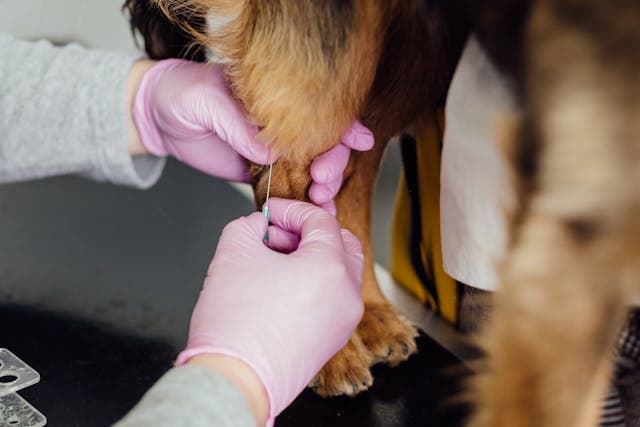
Luxating Patella

Our guide has been authored by qualified veterinarians, but should not be taken as substitute for medical advice or professional veterinary consultation. If your pet displays any unusual symptoms, we strongly advise seeking guidance from a veterinarian
Understanding Luxating Patella in dogs
Patellar luxation is a condition where the kneecap does not sit properly in the groove intended for it between the thigh bone and the knee (stifle) joint of the hind legs. The kneecap can dislocate inward or outward during movement and may return, or in more severe cases, become permanently stuck outside the groove. This condition can occur in one or both hind legs and is more common in small dog breeds, although it can occur in any breed.
Luxating Patella's Causes: Uncovering Triggers
In most cases, patellar luxation is a developmental disease with a hereditary background, meaning it involves a defect in the anatomical development of the bone structures and soft tissues (ligaments, tendons, muscles) of the knee joint. In a small percentage of cases, trauma may cause injury to the knee joint and lead to patellar luxation. In such cases, additional leg injuries such as hip dislocation, fractures, or cruciate ligament tears may also occur.
 Recognizing Luxating Patella: Signs and Symptoms
Recognizing Luxating Patella: Signs and Symptoms
- Limping: Can worsen with physical activity.
- Difficulty or reluctance to walk: Including holding the leg in the air for short periods or shaking the leg before walking on it.
- Sudden skipping or hopping: On three legs.
- Pain or discomfort: Sensitivity when touching the leg.
- Swelling: Around the knee joint due to inflammation.
- Muscle atrophy or weakness: In cases of chronic patellar luxation.
 Luxating Patella Diagnosis: How it's Identified
Luxating Patella Diagnosis: How it's Identified
In addition to delving into the dog’s medical history and trying to determine the nature and timing of the limping, the veterinarian will also perform a thorough physical examination, including an orthopedic examination of the front and hind legs. The most important examination for diagnosis is simple: manual manipulation of the patella, sometimes under sedation. In this examination, veterinarians feel the position of the patella relative to the groove of the joint, to determine if it is inward or outward. In cases where it is inward, the examination can determine whether it is easy to dislocate it from its position and whether it returns easily. X-rays under sedation can also demonstrate the extent of dislocation and the general alignment of the knee joint, including anatomical abnormalities.
 Treating Luxating Patella: Options and Approaches
Treating Luxating Patella: Options and Approaches
The problem is divided into four grades, from grade 1 being the mildest, to grade 4 being the most severe. Treatment options vary greatly depending on the severity of the disease and its severity:
In very mild cases (grade 1) where the problem is almost imperceptible, it may not be necessary to treat at all, but regular monitoring, appropriate physical activity, and maintaining a normal weight are important.
In grade 2 cases – a combination of essential nutritional supplements such as Omega 3 fatty acids, which support the joint and reduce the rate of cartilage wear, pain relievers and anti-inflammatory drugs, physical therapy, and hydrotherapy to strengthen muscles and alleviate pain may be used.
In grade 3-4 cases – where there is constant limping or frequent skipping and impairment in the dog’s quality of life, surgical intervention is advisable. This may include one or more surgical techniques, including:
Deepening the groove in the thigh bone where the kneecap sits to help it stay in place.
Tightening the soft tissues on the side where the patella dislocates and releasing on the other side – to prevent the dislocation movement from outside the groove
Changes in the knee bones themselves: moving the attachment points of the patellar ligament on the bone or thigh bone to shift it towards the center.
Luxating Patella: Surprising Facts

The kneecap, or patella, is the largest sesamoid bone in the body. Sesamoid bones are those that develop within tendons as a result of stress.

About 7% of all puppies suffer from some degree of patellar luxation.

About half of dogs suffering from patellar luxation on one side will also suffer from the problem on the other side.
 Vet's Tip: Dealing with Luxating Patella
Vet's Tip: Dealing with Luxating Patella
We all know it. The moment we get to the vet, suddenly everything is fine… But we believe you. Patellar luxation can appear and disappear without warning, so it would be very helpful for vets if you could record the limping in real-time, preferably from one angle from behind and one from the side. Good photography can be very helpful and accounts for 80% of the diagnostic process. If your dog is diagnosed with patellar luxation, help him maintain a normal weight as excess weight can put additional pressure on the joints and worsen the condition. Controlled physical activity is highly recommended in this context.




Price Tag

Latest in Research and Treatments
In recent years, the influence of neutering and spaying processes on several common medical conditions has been discovered. It has been found that the risk of patellar luxation is 2-3 times higher in neutered and spayed dogs compared to those who are not. This is due to the important role that sex hormones play in the proper development of the musculoskeletal systems. Large breeds are particularly susceptible to this because the full development of their joints can only be completed at one year of age and above. Therefore, it is advisable to carefully consider neutering and spaying at an early age, especially among breeds sensitive to the problem, and to wait for the completion of their physical development.
dogs breeds Prone to Luxating Patella
Did you know?
Enrolling in Animalia Pet Insurance
while your pet is healthy is a wise decision.
Waiting until a disease develops means it won't be covered.













